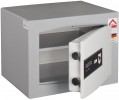Capacity
The volume of the interior space of the safe. Usually this parameter is indicated taking into account the safe-in-safe and other additional internal compartments. The amount of content that can be placed inside directly depends on the volume; on the other hand, it affects the external dimensions and weight of the storage.
Country of origin
The country where the safe is made as an entire product. For example, if a factory in Bulgaria takes a “box” welded in China and puts a German lock in it, then Bulgaria is indicated as the country of origin.
It is worth noting that the quality of the safe does not much depend on this parameter — generally it is worth looking rather not at the country of origin, but at the brand and price category of the product.
Now there are such safe-manufacturing countries on the market:
Bulgaria,
Great Britain,
Germany,
Italy,
China,
USA,
Slovakia,
France,
South Korea.
Number of locking bolts
The number of locking bolts provided in the design of a standard safe lock.
The locking bolt is a working element of the lock, which responds directly to the locking. It is a rod, disk, or other element (usually metal) that fits into a slot in the fixed part of the safe, blocking the opening of the door. The more such elements a safe has, the more reliable the lock and the lower the probability of opening the door by “brute force”.
This parameter in our catalog is indicated for one lock, regardless of their number in a safe. Most often, all safe locks have the same number of bolts.
Now on the market there are locks with the following number of locking bolts:
2,
3,
4,
5,
6 and
more.
Lock model
This paragraph indicates the manufacturer of the safe lock.
Number of shelves
The number of individual shelves provided in the design of the safe (if any). These structural elements make it easier to store small items: it is easier to lay out the "trifle" on separate shelves than to lay it in a continuous pile on the floor of the safe. On the other hand, shelves divide the overall volume of the safe into parts and can create difficulties for large items. Therefore, in gun safes (see "Product Type"), the shelves occupy only a part of the internal space, which is separated from the rest of the volume by a vertical partition.
Some safes provide the possibility of rearranging the shelves to different levels — similar to how it is implemented in refrigerators.
The minimum design of the safe provides
1 or
2 shelves, and in more advanced models their number can reach
3 or
more.
External dimensions (HxWxD)
The size of safe regarding its external dimensions. These figures will allow you to estimate how much space the safe takes up and whether it will fit into the intended installation location. Of course, greater capacity implies larger dimensions.
Internal dimensions (HxWxD)
Dimensions of the interior space of the safe. Note that in our catalog this parameter is indicated without a safe-in-safe, ammo compartment (see below) or other additional compartment provided inside.
This parameter directly determines the internal volume (see below). In addition, with the internal dimensions are known, you can determine whether this or that object will fit inside; this is especially important if you plan to use the safe for large items (for example, large-format documents that cannot be folded) — after all, in different models, the dimensions on three sides can vary significantly even with the same capacity.
Door thickness
This parameter means the actual thickness of the safe door; do not confuse it with wall thickness, see below. This dimension is measured excluding the lock and other protruding parts. It is one of the main factors determining the reliability and burglary resistance of a safe (see “Burglary resistance class”). In addition, regulatory documents may consist of direct requirements for certain categories of safes (for example, gun safes, "bank", etc.), including the minimum permissible door thickness.
Note that a thick door is especially important for embedded models (see "Product Type") — after all, in the normal position from the sides and back, the storage is protected by the wall it is mounted into, and the door remains outside.
Body thickness
The total thickness of the safe body, in other words, the thickness of the entire layer of material that separates the internal space of the safe from the environment. Do not confuse this parameter with the safe wall thickness (see below).
Most often, the dimensions of the walls are the same on the sides and back, so it is enough to indicate the general value in the specs. Anyway, the reliability and burglary resistance of a model, as well as its compliance with regulatory requirements, depend on this indicator — for certain areas of application (gun safes, bank safes, etc.), the terms of the legislation can be very detailed and prescribe even the lowest permissible body thickness.

